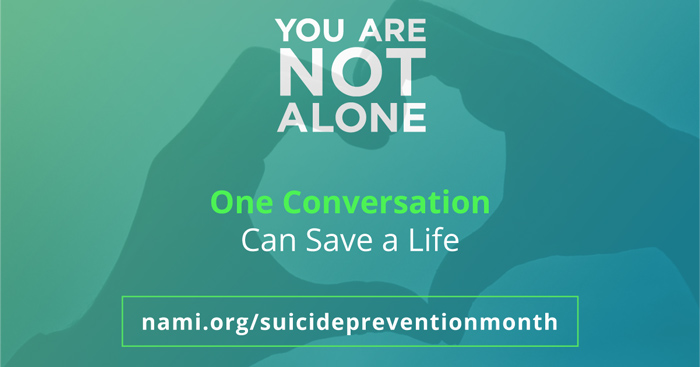September is a month which has double significance for the recovery community. It is both Suicide Prevention Month and Recovery Month. While recovery and suicide may seem unrelated, they are actually quite closely connected, so it is appropriate that they are brought into our awareness at the same time.
Mental Health and Addiction
Isolation and trauma feed both mental illness and addiction, so it is not surprising that suicidality can also be linked to substance use disorder. As explained by Psychology Today, the strongest predictor of suicide is actually alcoholism, not psychiatric diagnosis. In fact, the article goes on to state that people who struggle with substance use disorder are six times more likely to commit suicide than the general population.
Substances Are Not Just a Predictor
Not only is substance abuse a predictor for suicidality, but it is also a means by which some people choose to end their lives. A third of all suicides are the result of poisoning, with 75% of poisoning suicides involving drugs.
According to the Centers for Disease Control (CDC), there are numerous other risk factors for suicide:
- Family history of suicide or child abuse
- Previous suicide attempts
- Mental illness, especially depression
- Impulsive or aggressive behavior
- Feeling alone
- Barriers to mental health care (financial, cultural or personal)
- Physical illness
- Easy access to a method of suicide
How Substance Use Disorder Leads to Suicide
Alcohol and drugs may increase the risk of suicide in several ways, including:
- Those using substances may take risks they ordinarily would not.
- Many people use drugs or alcohol to self-medicate, which may work in the short-term but will make things worse in the long run.
- In recovery, people may be overwhelmed by emotions that they had been medicating with drugs. They may now be clear-headed enough to carry out suicidal plans.
- The consequences of addiction (legal problems, broken relationships, financial issues, job loss, etc.) may cause a person to lose hope of ever getting back on track.
High-Risk Times
The times when a person in recovery is at greatest risk for suicide is when they are dealing with a big change, either good or bad. These include:
- Entering or leaving treatment
- Relapsing
- Loss of a loved one
- Divorce
- Other major life changes
Protective Factors
While some factor increase suicide risk, other factors can reduce the chances of a person ending their own life. According to the CDC, these include:
- Effective treatment for mental, physical, and substance use disorders
- Easy access to clinical interventions
- Feeling connected to family, friends, and/or community
- Support from other people who understand what it’s like to live with their diagnoses
- Tools to problem-solve and resolve conflicts in nonviolent ways
- Cultural and religious beliefs that discourage suicide and support getting help
Suicide Prevention
Getting treatment for mental illness, physical illness, and substance use disorder is crucial. When a person is able to process everything they have been through, get needed medications, and feel like they have someone to talk to, they are less likely to attempt suicide.
It is also sometimes helpful to hear from other people who have felt hopeless and ready to give up, and to learn how they were able to move past this dark time of their lives. People in recovery can often find support of this type in their recovery groups, in group therapy, from their sponsor, or online. Thisismybrave.org is a site dedicated to sharing the stories of people who were once ready to end their lives but then overcame their pain and went on to lead happier lives. The site is currently in the process of producing special storytelling shows for teens and for those in the Black community.
Recovery
For people in recovery from substance use disorder or mental illness, September is also significant as a time to bring awareness to the hope of overcoming our pain and regaining the ability to drive our lives in the direction we want them to go. It is a time to break down stigma and educate people who may not understand the prevalence of addiction and mental illness or its impact on our society.
Most years, recovery month would likely involve face-to-face events like run/walks, picnics, or seminars to celebrate those in recovery and to educate people who might still be laboring under false beliefs about mental health or addiction. Due to the COVID-19 pandemic, many Recovery Month activities have gone virtual. For example, SAMHSA is offering free webinars available to help educate people who might wish to know more. In addition, the National Council for Behavioral Health has a free online toolkit for people who wish to spread the word about recovery. It includes a poster that shares the benefits of recovery, such as:
- Increased participation in family activities
- Decrease in mental health symptoms
- Improved employment outcomes
- Better likelihood of obtaining higher education
Safe Harbor Recovery Center is proud to celebrate the recovery journeys of our clients and grateful for the chance to have helped set them on the path to sobriety and mental health. If you or a loved one needs guidance from caring, compassionate mental health and substance use professionals, we are here to help.

